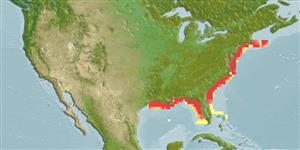Actinopterygii (ray-finned fishes) >
Cyprinodontiformes (Rivulines, killifishes and live bearers) >
Fundulidae (Topminnows and killifishes)
Etymology: Fundulus: Latin, fundus = bottom; a peculiar name for a topminnow, coined for a bottom species of Atlantic coast being "the abode of the fundulus mudfish" (Ref. 45335).
Environment / Climate / Range
Ecology
Marine; brackish; benthopelagic; non-migratory; depth range 0 - 1 m. Temperate; 10°C - 25°C (Ref. 2059), preferred ?; 44°N - 25°N, 95°W - 67°W
Western Atlantic: New Hampshire to northeastern Florida in USA; also in northern Gulf of Mexico.
Size / Weight / Age
Maturity: Lm ? range ? - ? cm
Max length : 18.0 cm TL male/unsexed; (Ref. 7251)
Dorsal
soft rays
(total): 14-15. Males have 15-20 dark bars on side; females have 2-3 longitudinal stripes (Ref. 26938).
Inhabits bays, estuaries and coastal marshes (Ref. 5723). Feeds on worms, small crustaceans, mollusks and insects (Ref. 93252). Not a seasonal killifish. Is difficult to maintain in aquarium (Ref. 27139).
Life cycle and mating behavior
Maturity | Reproduction | Spawning | Eggs | Fecundity | Larvae
May spawn several broods of eggs in a single season (Ref. 38947).
Huber, J.H., 1996. Killi-Data 1996. Updated checklist of taxonomic names, collecting localities and bibliographic references of oviparous Cyprinodont fishes (Atherinomorpha, Pisces). Société Française d'Ichtyologie, Muséum National d'Histoire Naturelle, Paris, France, 399 p. (Ref. 27139)
IUCN Red List Status (Ref. 115185)
CITES (Ref. 94142)
Not Evaluated
Threat to humans
Harmless
Human uses
Aquarium: commercial
Tools
Special reports
Download XML
Internet sources
Estimates of some properties based on models
Phylogenetic diversity index (Ref.
82805): PD
50 = 0.5000 [Uniqueness, from 0.5 = low to 2.0 = high].
Bayesian length-weight: a=0.00603 (0.00253 - 0.01433), b=3.08 (2.87 - 3.29), in cm Total Length, based on LWR estimates for this (Sub)family-body shape (Ref.
93245).
Trophic Level (Ref.
69278): 3.4 ±0.2 se; Based on size and trophs of closest relatives
Resilience (Ref.
69278): High, minimum population doubling time less than 15 months (Preliminary K or Fecundity.).
Vulnerability (Ref.
59153): Low vulnerability (24 of 100) .
